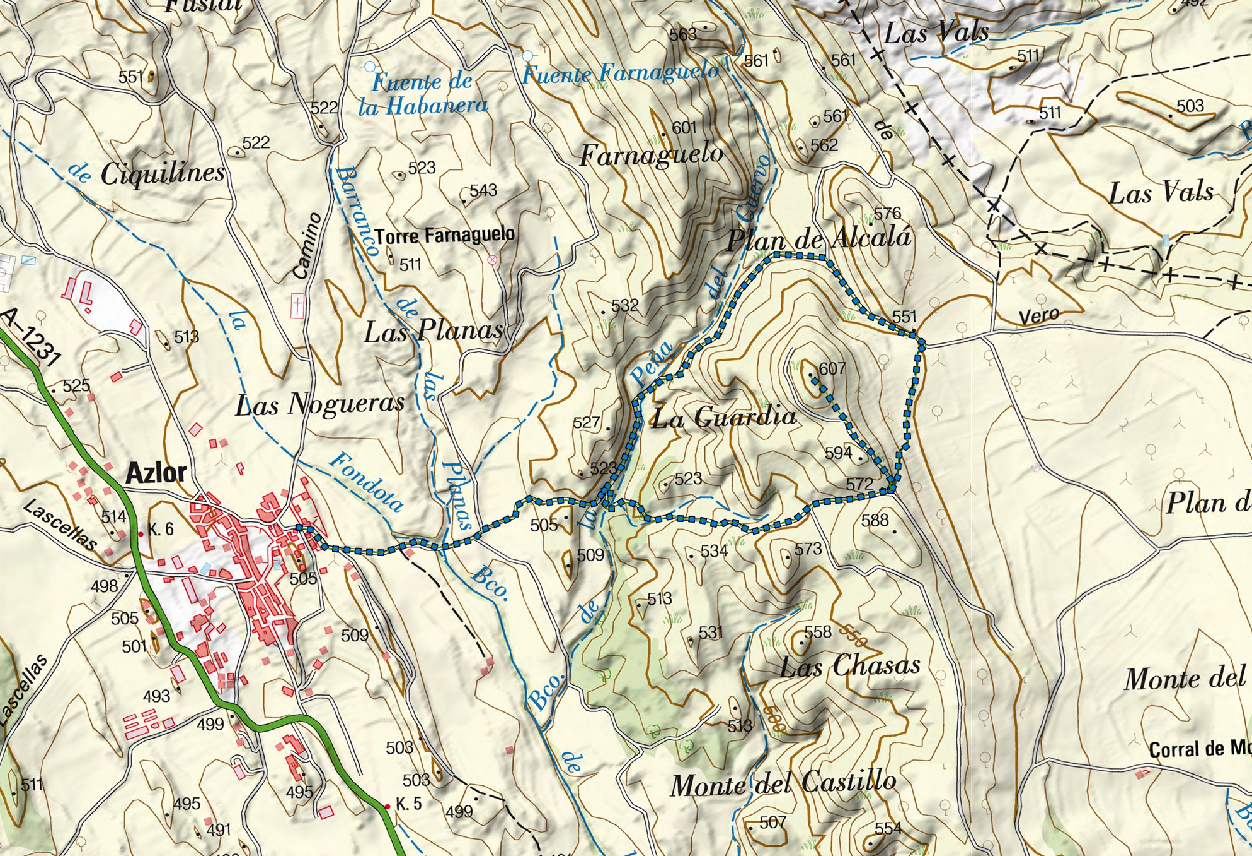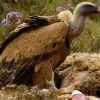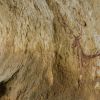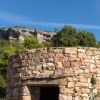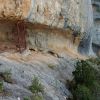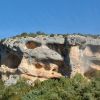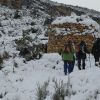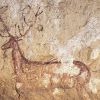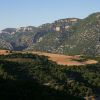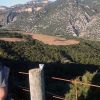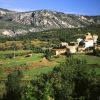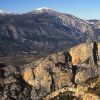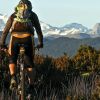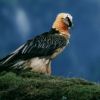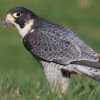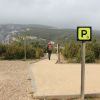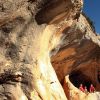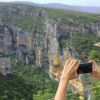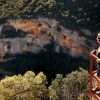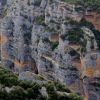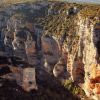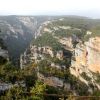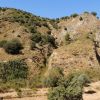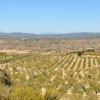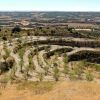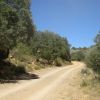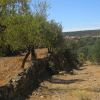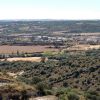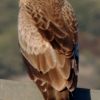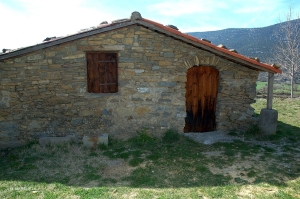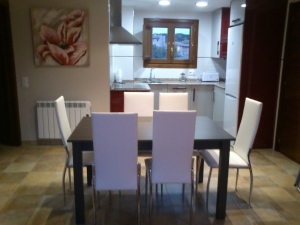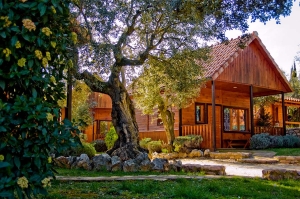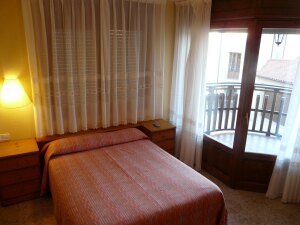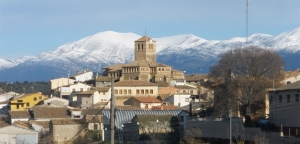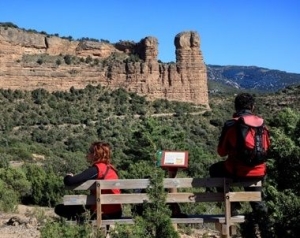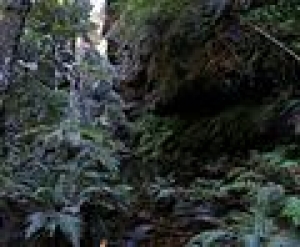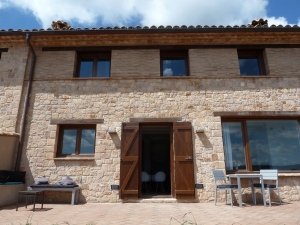Ecosistema Rupícola
Route Chimiachas Balcony. Alquézar
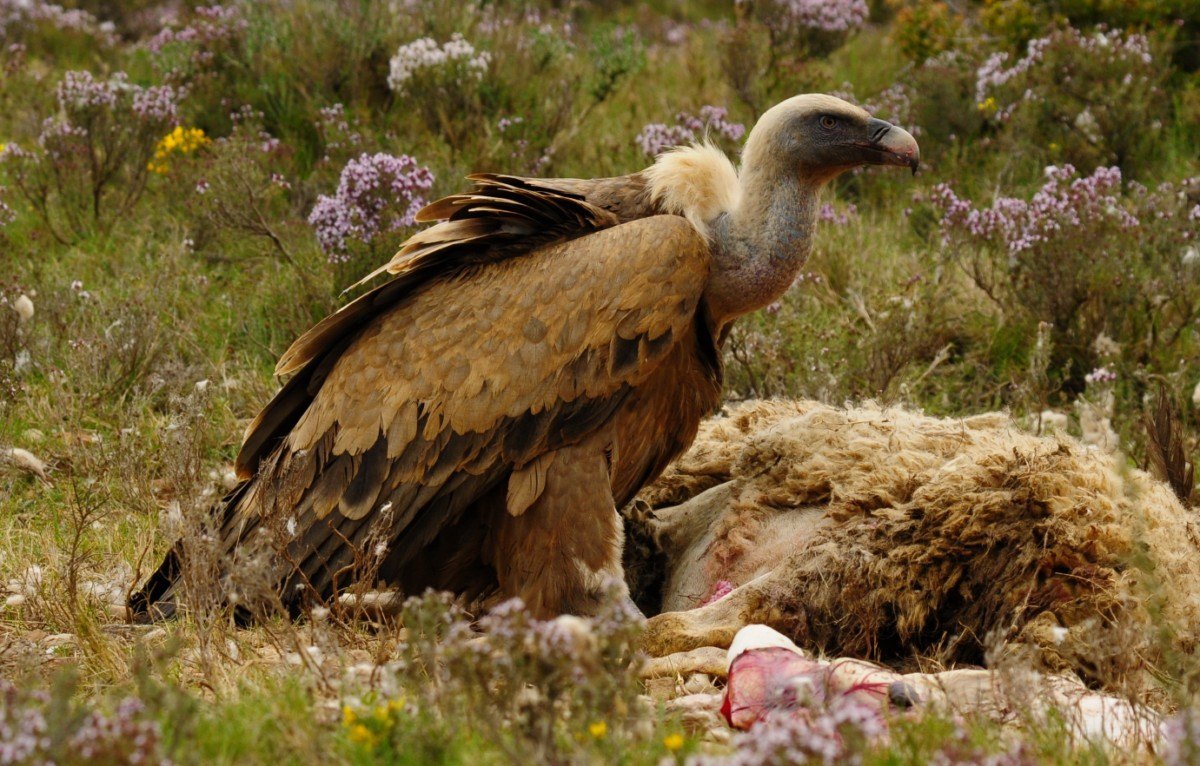
Technical information
Type of route: return hiking route
Departure point: Alquézar
KM: 12
Duration: 5 h
Gradient: 650 m
MIDE: 2-2-2-3
Access
From Alquézar, take the hiking route “Abrigo de Quizans y Chimiachas”.
Route description
The 5-hour return walk winds up from the village of Alquézar to Balsas de Basacol. From there, a path will lead us on top of the crests running parallel to the Vero River Canyon, through a rocky habitat where we can catch sight of large predators such as the Lammergeyer, Griffon Vulture or the Egyptian Vulture (three out of the four vultures existing in the Iberian Península), along with Peregrine Falcons, House Martins and the elusive Wallcreeper.
Main species
Representative bird: Griffon Vulture (Gyps fulvus)
Residents: Red-legged Partridge, Red Kite, Lammergeyer, Griffon Vulture, Eurasian Sparrowhawk, Common Buzzard, Common Kestrel, Peregrine Falcon, Golden Eagle, Rock Dove, Stock Dove, Wood Pigeon, Eagle Owl (rare), Little Owl, Long-eared Owl, Hoopoe, Green Woodpecker, Great Spotted Woodpecker, Crested Lark, Thekla Lark, Wood Lark, Crag Martin, Pied Wagtail, Winter Wren, European Robin, Black Redstart, Blue Rock Thrush, Mistle Thrush, Blackbird, Dartford Warbler, Sardinian Warbler, Common Firecrest, Long-tailed Tit, Crested Tit, Coal Tit, Blue Tit, Great Tit, Eurasian Jay, Magpie, Alpine Chough, Eurasian Jackdaw, Carrion Crow, Common Raven, Spotless Starling, Common Starling, House Sparrow, Tree Sparrow, Rock Sparrow, Chaffinch, European Serin, European Greenfinch, European Goldfinch, Linnet, Red Crossbill (irruptive), Cirl Bunting, Rock Bunting, Corn Bunting.
Summer migrants: Black Kite, Egyptian Vulture, Short-toed Snake Eagle, Booted Eagle, European Turtle Dove, Common Cuckoo, Red-necked Nightjar, Common Swift, Alpine Swift, European Bee-eater, Barn Swallow, Red-rumped Swallow, House Martin, Common Nightingale, Black-eared Wheatear, Common Rock Thrush, Melodious Warbler, Subalpine Warbler, Western Orphean Warbler, Bonelli’s Warbler, Spotted Flycatcher, Eurasian Golden Oriole, Woodchat Shrike.
Winter visitors: Northern Goshawk, Merlin, Eurasian Skylark, Meadow Pipit, Alpine Accentor, Fieldfare, Song Thrush, Eurasian Blackcap, Chiffchaff, Goldcrest, Wallcreeper, White-winged Snowfinch (rare), Brambling (rare), Eurasian Siskin (irruptive), Hawfinch, Yellowhammer.
Passage migrants: European Honey-buzzard, Harriers, Common Crane, Eurasian Woodcock (rare), Tree Pipit, Water Pipit, Common Redstart, Northern Wheatear, Redwing, Willow Warbler, Garden Warbler, Common Whitethroat, Pied Flycatcher.
Photo gallery
Map
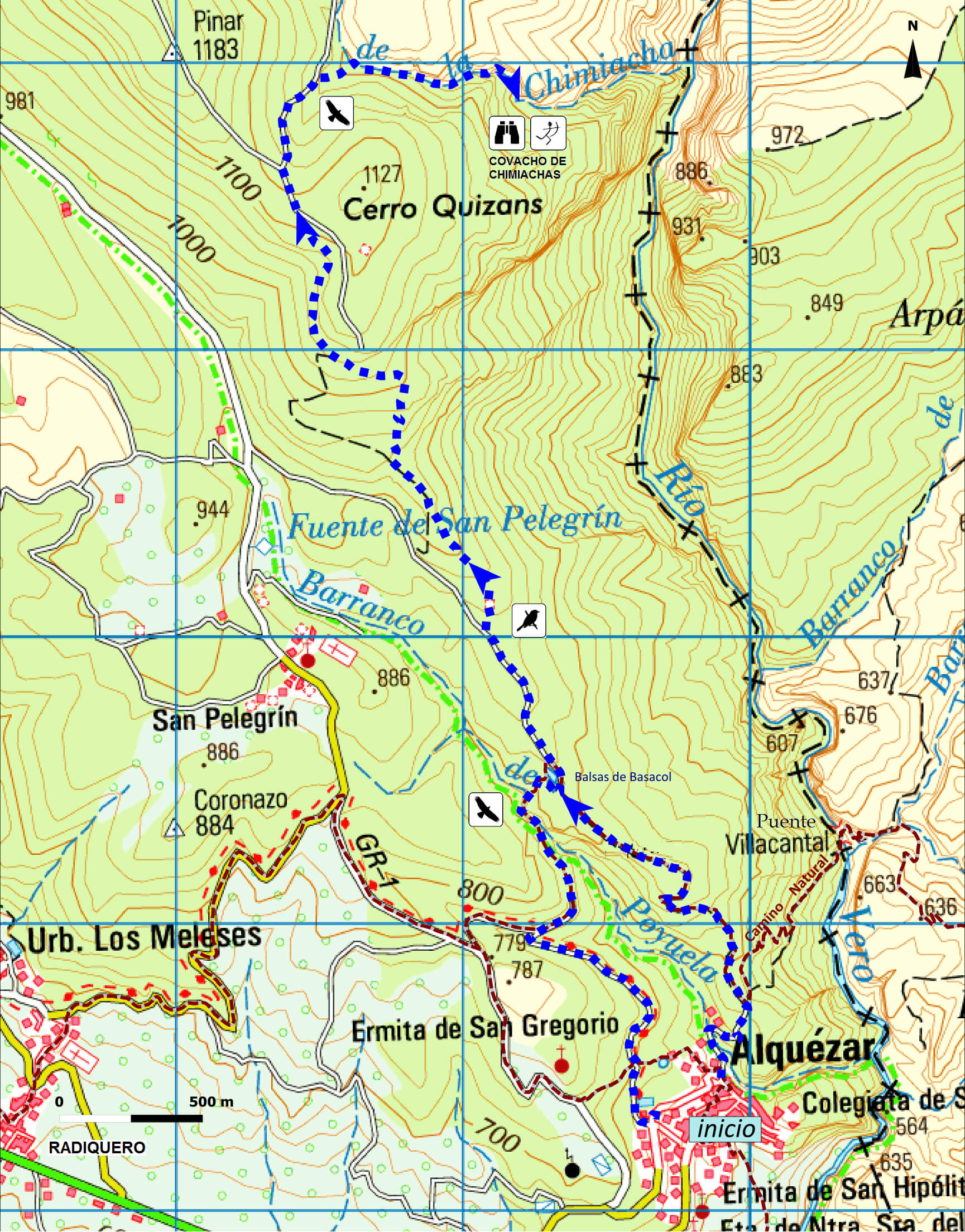
Route Balces Summits. Bierge
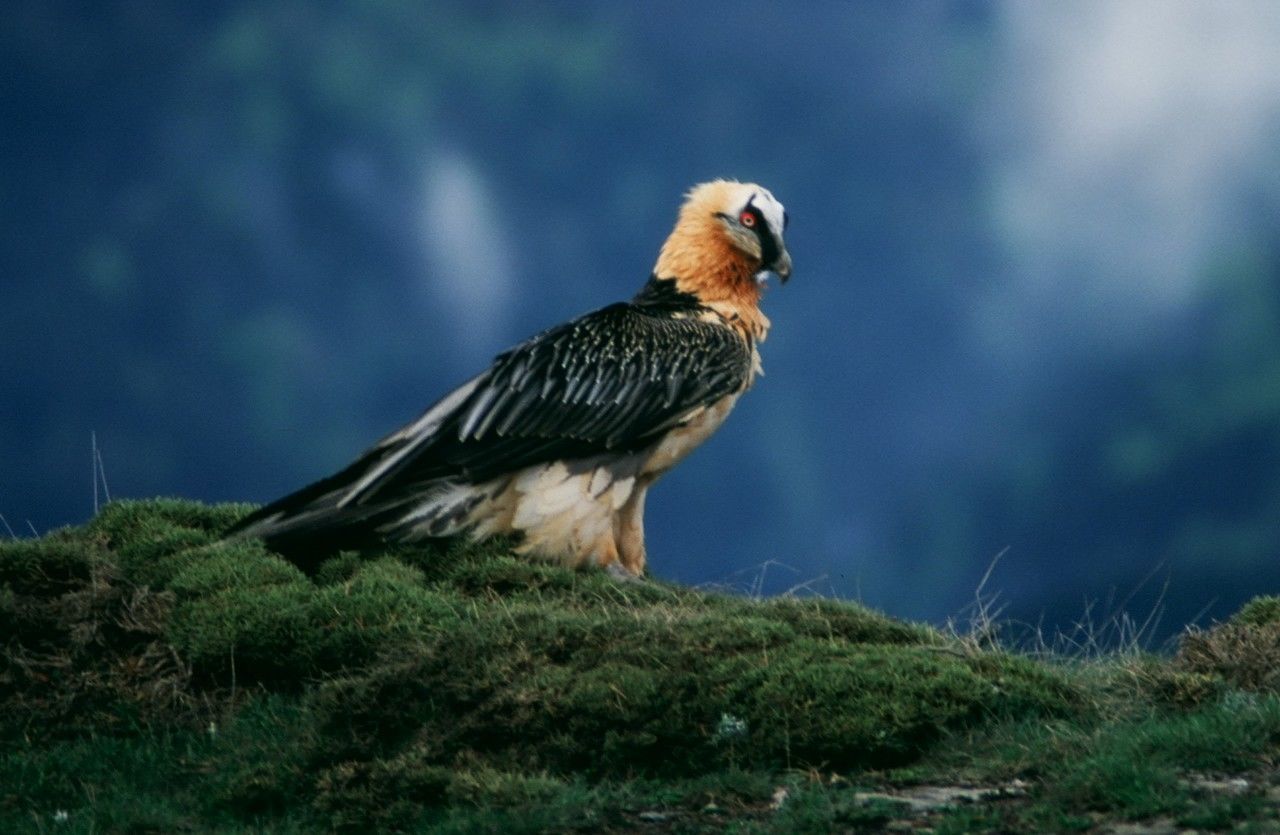
Technical information
Type of route: return hiking route
Departure point: Bierge
KM: 9
Duration: 3 h
Gradient: 375 m
MIDE: 1-2-2-3
Access
From Bierge take the road HU-341 heading towards Rodellar. After walking through the first 9.5 km., turn to the right. Drive approximately 1,5 km. until you reach a parking/ picnic area (at the time of the visit, the track was in poor condition, but they were fixing it. Practicable for all tipes of vehicles).
Route description
The route begins at road HU-341, 9.5 km from Bierge towards Rodellar. At this point, you should take a path to the East, which is accesible on foot or by vehicle, up to a picnic area (1,5 km). From here, you can continue on foot following the signposts for “Cresta del Balcés”. The path ascends about 3 km, until you get an overview of the entire valley and the surrounding crags, where you will be able to observe three Pyrenean vultures, Peregrine Falcon and Golden Eagle.
Main Species
Representative bird: Lammergeyer (Gypaetus barbatus)
Residents: Red-legged Partridge, Red Kite, Lammergeyer, Griffon Vulture, Eurasian Sparrowhawk, Common Buzzard, Common Kestrel, Peregrine Falcon, Golden Eagle, Rock Dove, Stock Dove, Wood Pigeon, Eagle Owl (rare), Little Owl, Long-eared Owl, Hoopoe, Great Spotted Woodpecker, Crested Lark, Thekla Lark, Wood Lark, Crag Martin, Pied Wagtail, Eurasian Wren, European Robin, Black Redstart, Blue Rock Thrush, Mistle Thrush, Blackbird, Dartford Warbler, Sardinian Warbler, Common Firecrest, Long-tailed Tit, Crested Tit, Coal Tit, Blue Tit, Great Tit, Eurasian Jay, Magpie, Alpine Chough, Eurasian Jackdaw, Carrion Crow, Common Raven, Spotless Starling, Common Starling, House Sparrow, Eurasian Tree Sparrow, Rock Sparrow, Chaffinch, European Serin, European Greenfinch, European Goldfinch, Linnet, Red Crossbill (irruptive), Cirl Bunting, Rock Bunting, Corn Bunting.
Summer migrants: Black Kite, Egyptian Vulture, Short-toed Snake Eagle, Booted Eagle, European Turtle Dove, Common Cuckoo, Red-necked Nightjar, Common Swift, Alpine Swift, European Bee-eater, Barn Swallow, House Martin, Common Nightingale, Black-eared Wheatear, Common Rock Thrush, Melodious Warbler, Subalpine Warbler, Western Orphean Warbler, Bonelli’s Warbler, Spotted Flycatcher, Eurasian Golden Oriole, Woodchat Shrike.
Winter visitors: Northern Goshawk, Merlin, Eurasian Skylark, Meadow Pipit, Alpine Accentor, Fieldfare, Song Thrush, Eurasian Blackcap, Chiffchaff, Goldcrest, Wallcreeper, White-winged Snowfinch (rare), Eurasian Siskin (irruptive), Yellowhammer.
Passage migrants: European Honey-buzzard, Harriers, Common Crane, Eurasian Woodcock (rare), Tree Pipit, Water Pipit, Common Redstart, Northern Wheatear, Redwing (irruptive), Willow Warbler, Garden Warbler, Common Whitethroat, Pied Flycatcher.
Photo gallery
Map
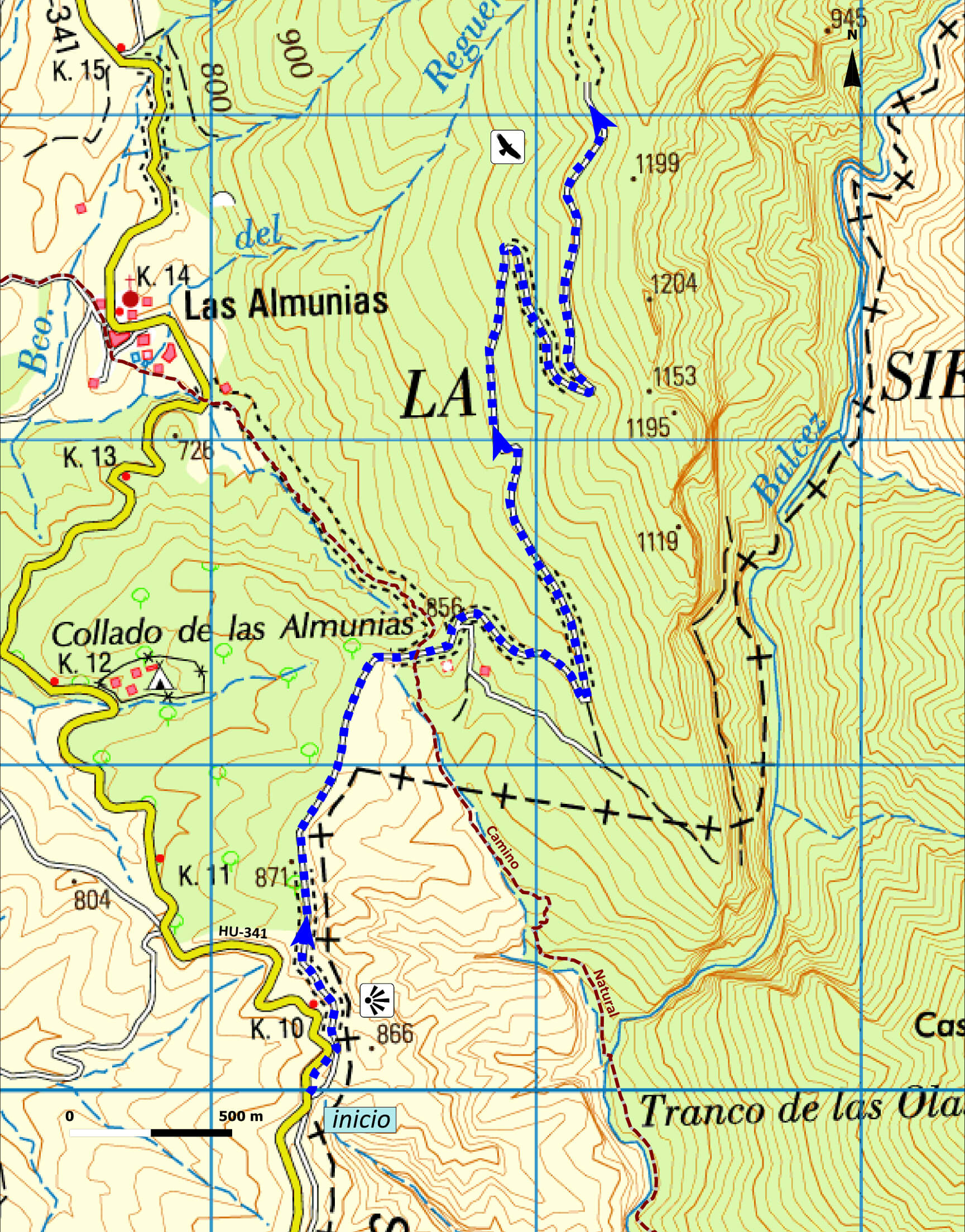
Route to Mallata Hillock. Colungo
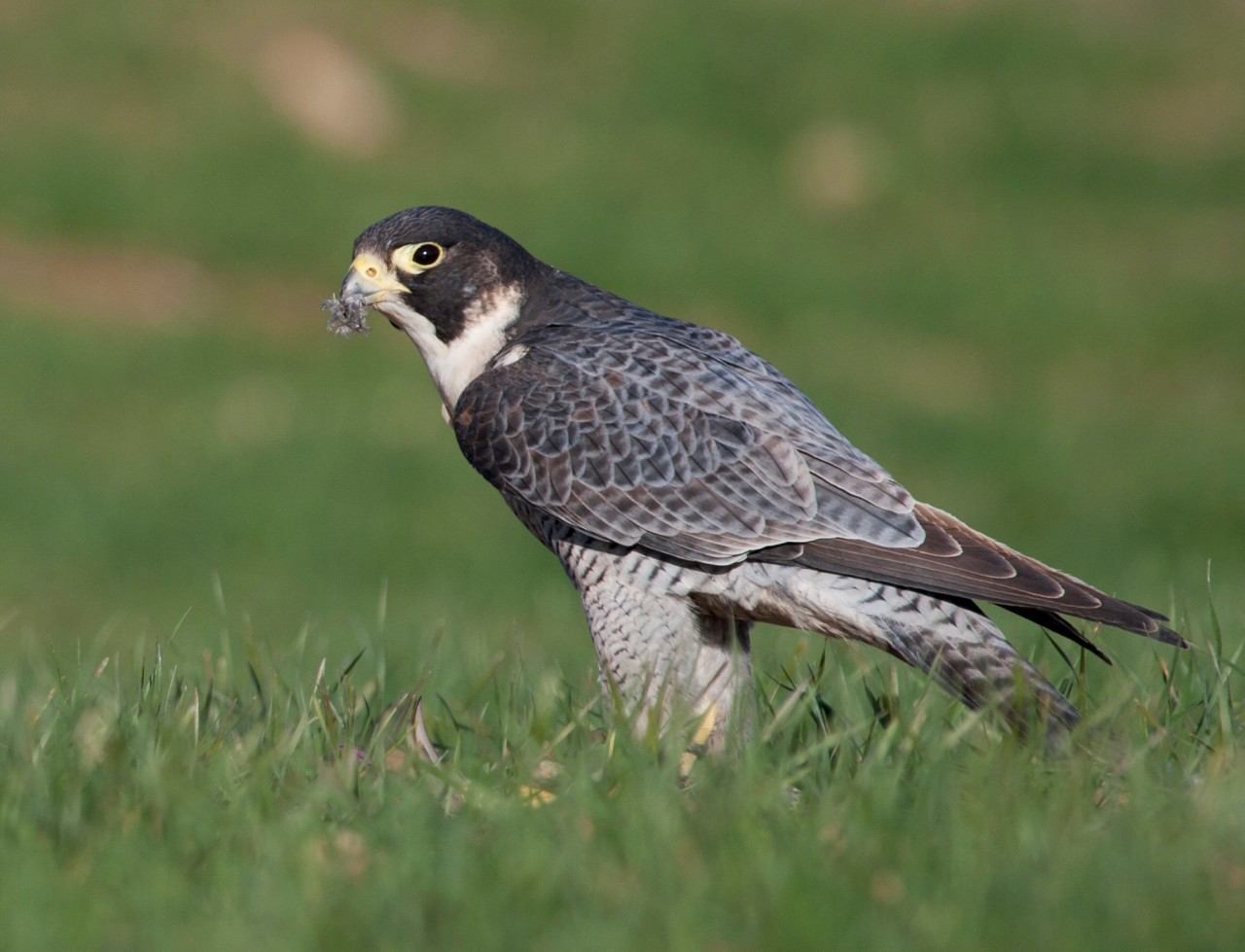
Technical information
Type of route: return hiking route
Departure point: Colungo
KM: 2,2
Duration: 1 h
Gradient: 186 m
MIDE: 1-2-2-2
Access
From Colungo, take the road A-2205 towards Arcusa until you reach parking of the “Barranco de la Portiacha” (13 km) where you should leave the car and continue on foot along a pathway that leads to the Mallata hillock (shelter with cave paintings).
Route description
From the village of Colungo, we take road A-2205 towards Arcusa until we reach the Barranco de Portiacha parking (13 km) where we leave the car. Beside the parking is the balcony on the Vero River , of extraordinariry scenic beauty with its rocky atmosphere, from which we can observe sandstones and fluvial conglomerates. From here we can access the second viewpoint (Tozal de Mallata, shelter with cave paintings), by taking a small 1,1 km footpath, through mountain scrublands.
Main Species
Representative bird: Peregrine Falcon (Falco peregrinus)
Residents: Red-legged Partridge, Red Kite, Lammergeyer, Griffon Vulture, Eurasian Sparrowhawk, Common Kestrel, Peregrine Falcon, Golden Eagle, Rock Dove, Stock Dove, Wood Pigeon, Eagle Owl (rare), Little Owl, Long-eared Owl, Hoopoe, Green Woodpecker, Great Spotted Woodpecker, Crested Lark, Thekla Lark, Wood Lark, Crag Martin, Pied Wagtail, Wren, European Robin, Black Redstart, Blue Rock Thrush, Mistle Thrush, Blackbird, Dartford Warbler, Sardinian Warbler, Common Firecrest, Long-tailed Tit, Crested Tit, Coal Tit, Blue Tit, Great Tit, Eurasian Jay, Magpie, Alpine Chough, Eurasian Jackdaw, Carrion Crow, Common Raven, Spotless Starling, Common Starling, House Sparrow, Eurasian Tree Sparrow, Rock Sparrow, Chaffinch, European Serin, European Greenfinch, European Goldfinch, Linnet, Red Crossbill (irruptive), Cirl Bunting, Rock Bunting.
Summer migrants: Black Kite, Egyptian Vulture, Short-toed Snake Eagle, Booted Eagle, European Turtle Dove, Common Cuckoo, Red-necked Nightjar, Common Swift, Alpine Swift, European Bee-eater, Barn Swallow, Red-rumped Swallow, House Martin, Common Nightingale, Black-eared Wheatear, Common Rock Thrush, Melodious Warbler, Subalpine Warbler, Western Orphean Warbler, Bonelli’s Warbler, Spotted Flycatcher, Eurasian Golden Oriole, Woodchat Shrike.
Winter visitors: Northern Goshawk, Merlin, Eurasian Skylark, Meadow Pipit, Alpine Accentor, Fieldfare, Song Thrush, Eurasian Blackcap, Chiffchaff, Goldcrest, wallcreeper, White-winged Snowfinch (rare), Brambling (rare), Eurasian Siskin (irruptive), Hawfinch, Yellowhammer.
Passage migrants: European Honey-buzzard, Harriers, Black Stork (rare), Common Crane, Eurasian Woodcock (rare), Tree Pipit, Water Pipit, Common Redstart, Northern Wheatear, Redwing, Willow Warbler, Garden Warbler, Common Whitethroat, Pied Flycatcher.
Photo gallery
Map
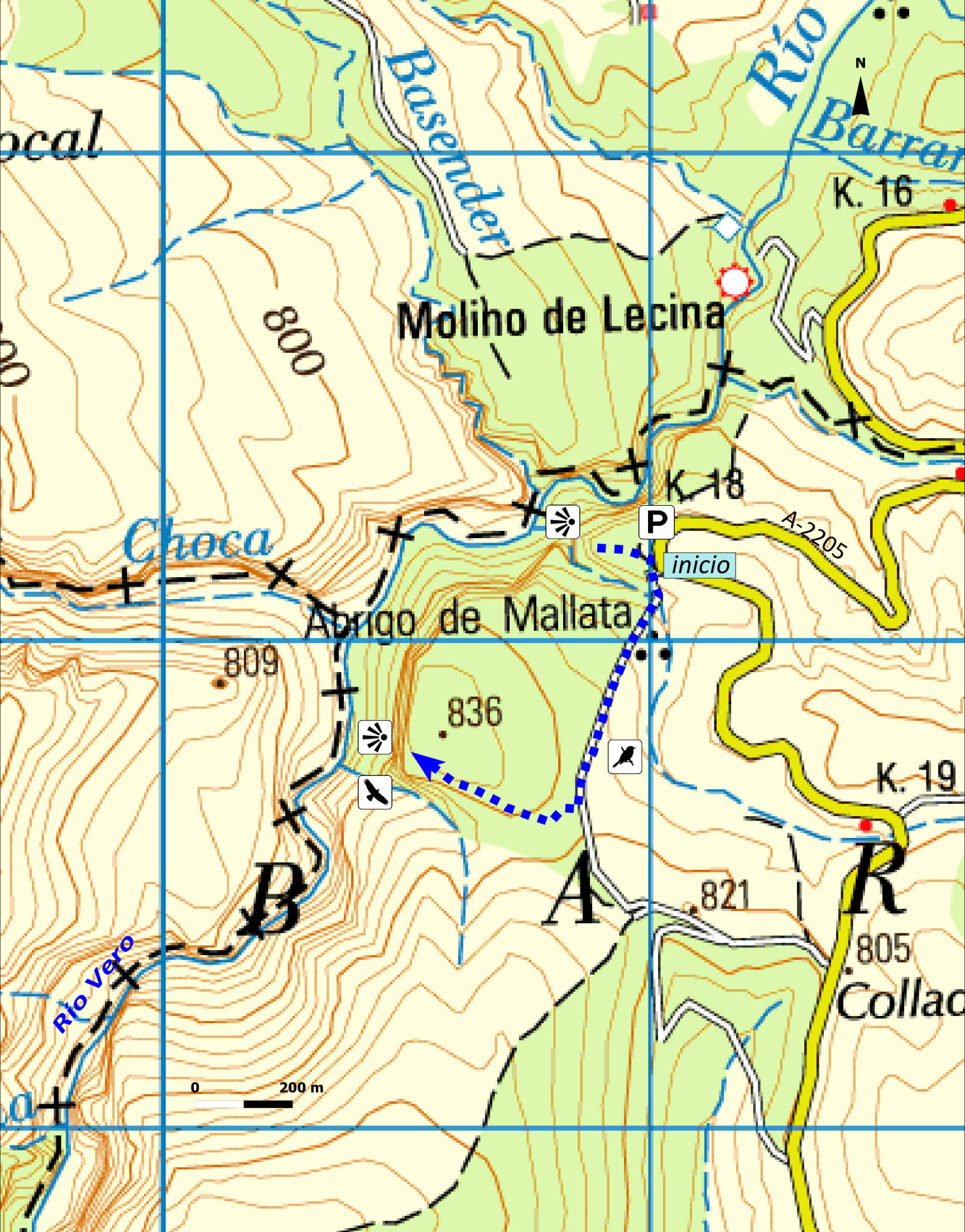
Ruta Somontano mediterráneo. Azlor
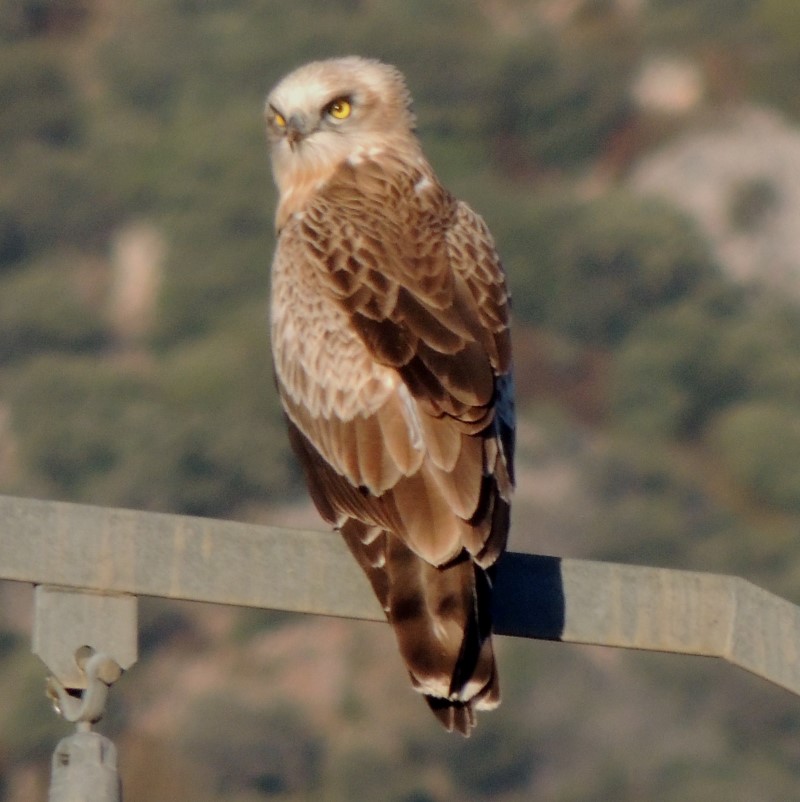
Technical information
Type of route: circular hiking route
Departure point: Azlor
KM: 4
Duration: 1 h 15 min
Gradient: 120 m
MIDE: 1-2-2-2
Access
From Huesca or Barbastro, take the A22 motorway to the Abiego/Alquezar exit next to the River Alcanadre and continue along the A1229. Just before Abiego take the turning eastbound to the village of Azlor along the A1231.
Route description
Circular 4 km walking route. From the village of Azlor take the eastbound track that forms the start of the “Huerta del Vero” route. It ascends parallel to the “Peña del Cuervo” gully and surrounds “La Guardia” hill returning on the opposite side.
The route traverses hilly countryside of sandstone escarpments and cultivated fields, predominantly almond orchards, oak groves and patches of rosemary. As you progress along it you cross the Las Planas and Peñas del Cuervo gullies, colonized by the poplars and brambles typical of more humid environments. It is possible to see a great variety of passerines (goldfinches, greenfinches, long-tailed tit, etc.) and two large species of birds of prey, the short-toed eagle and the booted eagle, perpetually on the hunt.
An ascent to the top of “La Guardia” hill (607 m) is recommended for the spectacular mosaic view of Mediterranean oak and almond groves.
Main Species
Representative bird: Short-toed eagle
Residents: Western marsh harrier, Long-eared Owl, Stone Curlew, Red-legged Partridge, Griffon Vulture, Common Buzzard, Common Kestrel, Rock Dove, Stock Dove, Wood Pigeon, Eagle Owl (rare), Little Owl, Long-eared Owl, Hoopoe, Green Woodpecker, Great Spotted Woodpecker, Crested Lark, Wood Lark, Crag Martin, Pied Wagtail, Eurasian Wren, European Robin, Black Redstart, Blue Rock Thrush, Mistle Thrush, Blackbird, Eurasian Blackcap, Sardinian Warbler, Common Firecrest, Long-tailed Tit, Crested Tit, Coal Tit, Blue Tit, Great Tit, Eurasian Jay, Magpie, Eurasian Jackdaw, Carrion Crow, Common Raven, Spotless Starling, Common Starling, House Sparrow, Eurasian Tree Sparrow, Rock Sparrow, Chaffinch, European Serin, European Greenfinch, European Goldfinch, Linnet, Cirl Bunting, Rock Bunting, Corn Bunting.
Summer migrants: Short-toed Sanake Eagle, Booted Eagle, Egyptian Vultare, Western Bonelli's Warbler, Black Kite, European Turtle Dove, Common Cuckoo, European Nightjar, Red-necked Nightjar, Common Swift, European Bee-eater, Barn Swallow, Red-rumped Swallow, House Martin, Common Nightingale, Black-eared Wheatear, Common Rock Thrush, Melodious Warbler, Subalpine Warbler, Western Orphean Warbler, , Spotted Flycatcher, Eurasian Golden Oriole, Woodchat Shrike.
Winter visitors: Men Harrier, Merlin, Rock Bunting, Red Kite, zorzal común, zorzal real (raro), zorzal alirrojo (raro), curruca capirotada, mosquitero común, estornino pinto,
Passage migrants: Willow Warbler, Common Redstart, European Honey Buzzard, Common Crane, Eurasian Woodcock (rare), Tree Pipit, Water Pipit, Common Redstart, Northern Wheatear, Redwing, Garden Warbler, Common Whitethroat, Pied Flycatcher.
Photo gallery
Map
